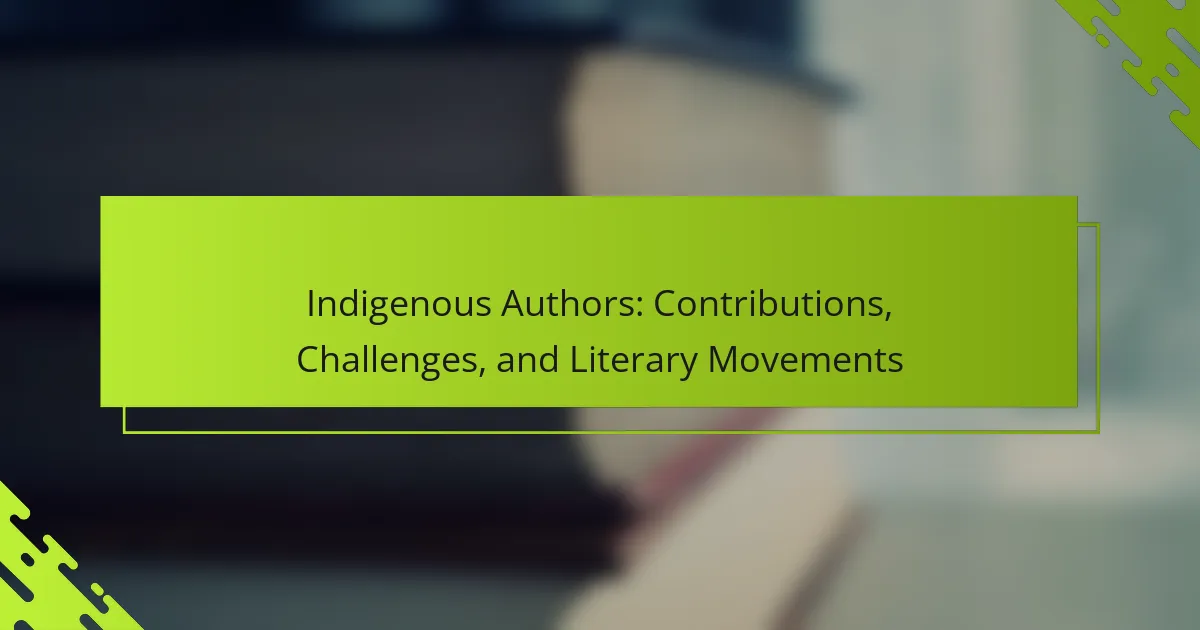Indigenous authors face significant challenges in the literary world, such as marginalisation and limited access to publishing resources. Their contributions enrich contemporary literature through unique perspectives and cultural narratives. Notable movements highlight the resurgence of oral storytelling traditions and the blending of traditional narratives with modern themes. Authors like Louise Erdrich and Tommy Orange offer authentic voices that resonate widely while addressing social justice and cultural preservation.
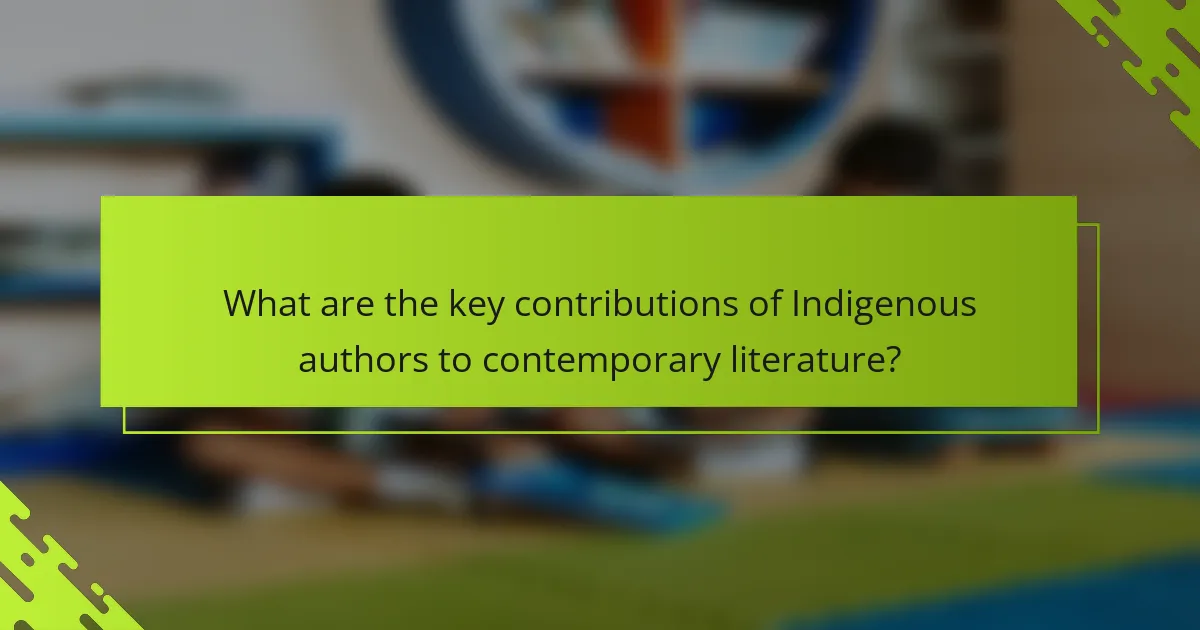
What are the key contributions of Indigenous authors to contemporary literature?
Indigenous authors significantly enrich contemporary literature through unique perspectives, cultural narratives, and social commentary. Their contributions highlight historical injustices and celebrate resilience, fostering greater awareness and understanding.
Notable movements include the resurgence of oral storytelling traditions and the incorporation of Indigenous languages. Authors like Louise Erdrich and Tommy Orange challenge stereotypes, offering authentic voices that resonate across diverse audiences.
The challenges they face, such as marginalisation and limited access to publishing resources, further inform their work. This context deepens the impact of their narratives, making their contributions vital to the literary landscape.
Overall, Indigenous authors play a crucial role in shaping contemporary literature by blending traditional elements with modern themes, thus enriching the global literary discourse.
How do Indigenous authors reflect cultural identity in their works?
Indigenous authors reflect cultural identity through storytelling, language, and themes that resonate with their communities. Their works often explore history, spirituality, and the connection to land, emphasising unique cultural perspectives. For example, authors like Louise Erdrich and Thomas King incorporate traditional narratives and contemporary issues, highlighting the resilience of Indigenous cultures. This approach not only preserves cultural heritage but also challenges stereotypes and fosters understanding among diverse audiences.
Which themes are prevalent in Indigenous literature?
Prevalent themes in Indigenous literature include identity, colonisation, spirituality, and community. These themes reflect the experiences and histories of Indigenous peoples.
Identity exploration often highlights the struggle between traditional ways and modern influences. Colonisation narratives address the impacts of European settlement on Indigenous cultures. Spirituality is woven through stories, emphasising connections to nature and ancestral knowledge. Community themes focus on the importance of kinship and collective resilience.
Indigenous authors contribute unique perspectives, showcasing their rich cultural heritage through diverse literary movements. These themes continue to evolve, addressing contemporary issues while preserving traditional storytelling.
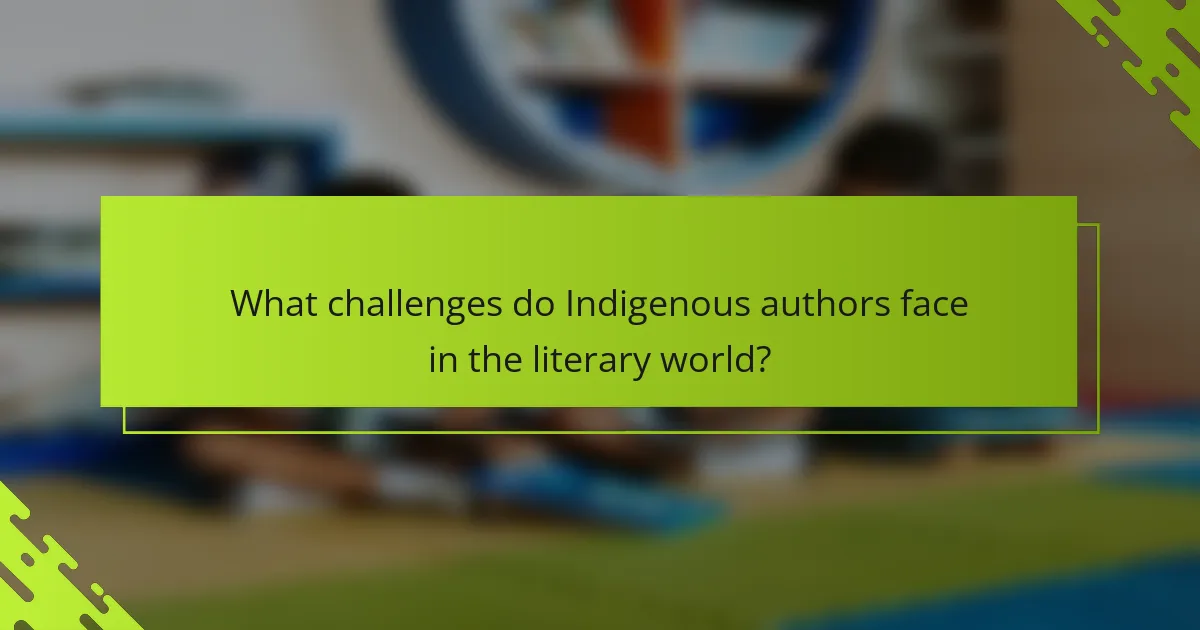
What challenges do Indigenous authors face in the literary world?
Indigenous authors face significant challenges in the literary world, including systemic barriers, cultural misrepresentation, and limited access to publishing resources. These obstacles hinder their visibility and ability to share authentic narratives. Many Indigenous writers struggle with the pressure to conform to mainstream expectations, which often leads to the dilution of their unique cultural identities. Additionally, the lack of representation in literary awards and media further compounds these challenges, making it difficult for Indigenous voices to gain recognition and support.
How do systemic barriers impact Indigenous writers?
Systemic barriers significantly hinder Indigenous writers by limiting access to resources, publishing opportunities, and visibility. These challenges stem from historical marginalisation and ongoing discrimination, impacting their ability to share authentic narratives. Additionally, cultural misunderstandings often lead to misrepresentation in mainstream literature. As a result, Indigenous authors face unique obstacles in gaining recognition and support for their work.
What role does cultural appropriation play in Indigenous literature?
Cultural appropriation often undermines Indigenous literature by commodifying and misrepresenting Indigenous voices. This appropriation can dilute authentic narratives, leading to the erasure of cultural significance and context. Indigenous authors face challenges in reclaiming their stories while navigating a literary landscape influenced by external interpretations. As a result, their contributions highlight the need for respectful engagement with Indigenous cultures and narratives.
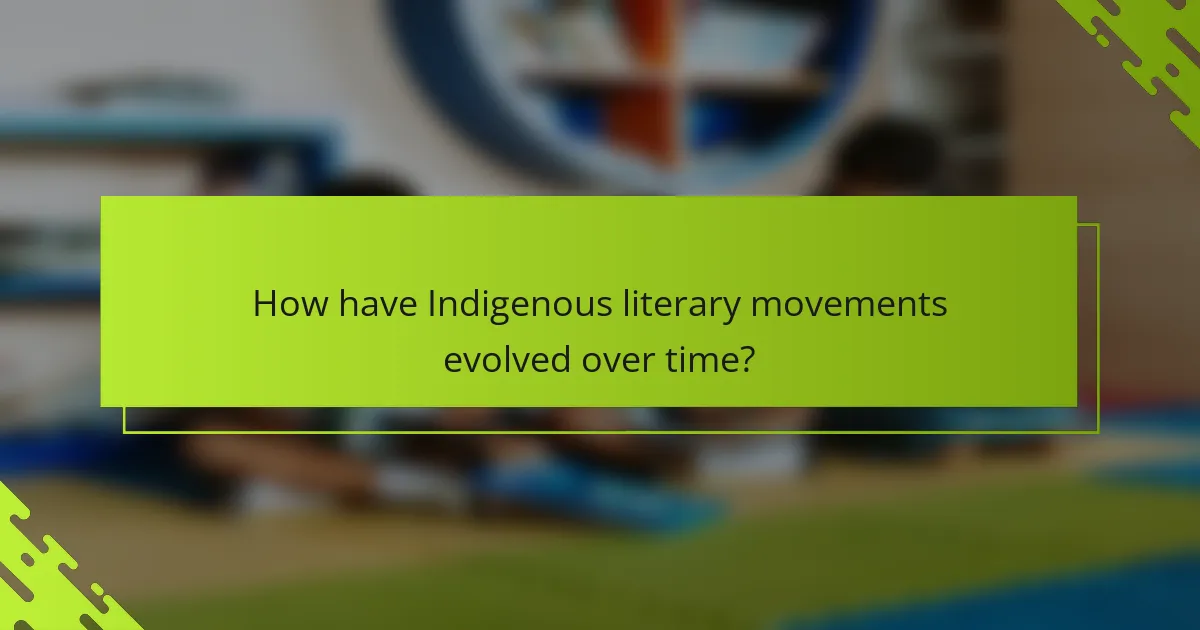
How have Indigenous literary movements evolved over time?
Indigenous literary movements have evolved significantly, reflecting cultural resilience and adaptation. Early works often focused on oral traditions and storytelling, emphasising community and identity. Over time, Indigenous authors began to address contemporary issues, blending traditional narratives with modern themes.
The rise of post-colonial literature marked a unique attribute, as authors sought to reclaim their voices and challenge dominant narratives. Movements such as the Native American Renaissance in the 1960s and 1970s highlighted this shift, showcasing diverse perspectives and experiences.
Today, Indigenous literature continues to thrive, incorporating various genres and forms while addressing social justice, environmental concerns, and cultural preservation. This evolution underscores the dynamic nature of Indigenous storytelling and its role in shaping cultural discourse.
What is the significance of the Native American Renaissance?
The Native American Renaissance is significant for revitalising Indigenous literature and culture. This movement, emerging in the late 20th century, saw a surge in works by Native authors who addressed historical trauma, identity, and contemporary issues. It fostered a greater understanding of Indigenous perspectives and experiences in American literature. Notable figures, such as Leslie Marmon Silko and N. Scott Momaday, contributed to this literary resurgence, enriching the cultural landscape. This renaissance has also challenged stereotypes and promoted Indigenous voices, making it a pivotal moment in American literary history.
How do contemporary Indigenous movements influence literature today?
Contemporary Indigenous movements significantly influence literature by promoting authentic voices and narratives. These movements challenge stereotypes and advocate for cultural representation. Indigenous authors like Tommy Orange and Louise Erdrich address historical trauma and resilience, enriching the literary landscape. Their works often reflect unique attributes of Indigenous identity, blending traditional storytelling with modern themes. This fusion resonates with diverse audiences, fostering greater understanding and appreciation of Indigenous cultures.
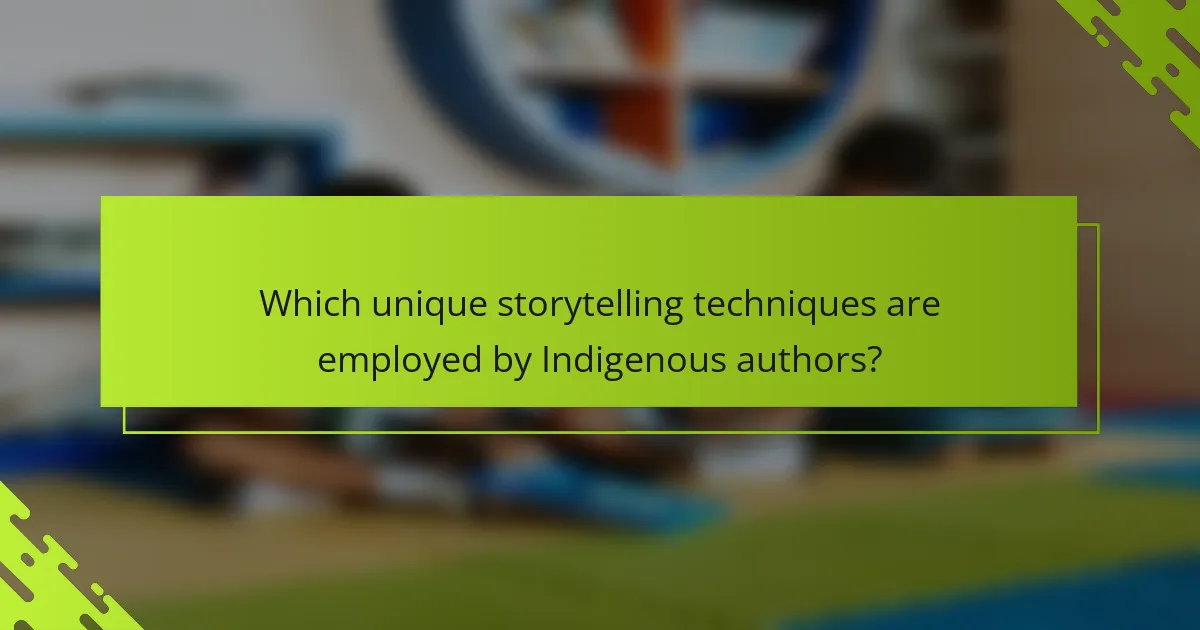
Which unique storytelling techniques are employed by Indigenous authors?
Indigenous authors employ unique storytelling techniques such as oral traditions, intergenerational narratives, and cultural symbolism. These methods reflect their deep connections to land and community, emphasising collective memory and identity. Oral traditions allow for dynamic storytelling, while intergenerational narratives pass down wisdom and experiences. Cultural symbolism enriches the text, creating layers of meaning unique to Indigenous perspectives.
How do oral traditions shape written works?
Oral traditions significantly influence written works by preserving cultural narratives and enhancing storytelling techniques. Indigenous authors often draw from oral histories, embedding rich symbolism and community values into their literature. This connection fosters authenticity and depth, allowing readers to engage with the cultural context. Furthermore, oral traditions challenge conventional literary forms, prompting innovative narrative structures and styles. As a result, Indigenous literature becomes a dynamic interplay of voice, heritage, and contemporary issues, reflecting the resilience of these communities.
What role does language play in Indigenous literature?
Language plays a crucial role in Indigenous literature by preserving culture and identity. It serves as a medium for storytelling, conveying traditions, and expressing unique worldviews. Indigenous authors often use their native languages to reflect their heritage, infusing their works with cultural significance. This linguistic diversity enhances the richness of their narratives and fosters a deeper connection with readers. Furthermore, the challenges faced in language preservation highlight the importance of revitalising Indigenous languages within literature.
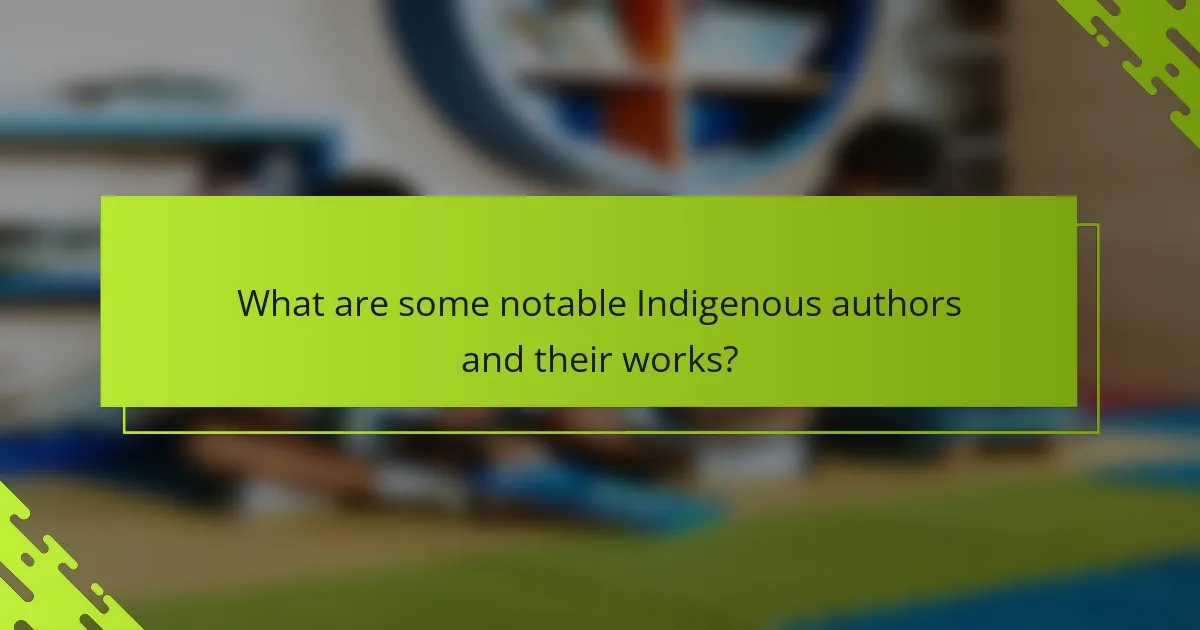
What are some notable Indigenous authors and their works?
Notable Indigenous authors include Louise Erdrich, Sherman Alexie, and N. Scott Momaday. Their works reflect cultural heritage and address contemporary issues.
Louise Erdrich’s “Love Medicine” explores themes of family and identity among Native Americans. Sherman Alexie’s “The Lone Ranger and Tonto Fistfight in Heaven” combines humour and tragedy to depict life on a reservation. N. Scott Momaday’s “House Made of Dawn” won the Pulitzer Prize and highlights the connection between land and identity.
These authors confront challenges such as representation and cultural preservation while contributing to literary movements that promote Indigenous voices. Their unique perspectives enrich the literary landscape and foster greater understanding of Indigenous experiences.
Which authors have gained international recognition?
Several Indigenous authors have gained international recognition for their contributions to literature, reflecting their unique cultural perspectives. Notable figures include Louise Erdrich, a member of the Turtle Mountain Band of Chippewa, known for her novels that explore Native American life. Another prominent author is Sherman Alexie, whose works often address themes of identity and resilience. Additionally, Thomas King, a member of the Cherokee Nation, has received acclaim for his storytelling that blends humour with social commentary. These authors highlight the rich literary movements emerging from Indigenous experiences globally.
What are the contributions of specific regional authors?
Indigenous authors significantly contribute to literature by reflecting cultural heritage, social issues, and historical narratives. They face challenges such as underrepresentation and limited access to publishing resources. Notable movements include the resurgence of oral storytelling and contemporary Indigenous literature, which emphasise identity and resilience. Authors like Louise Erdrich and Sherman Alexie highlight these themes through their works, fostering greater awareness and appreciation of Indigenous perspectives.
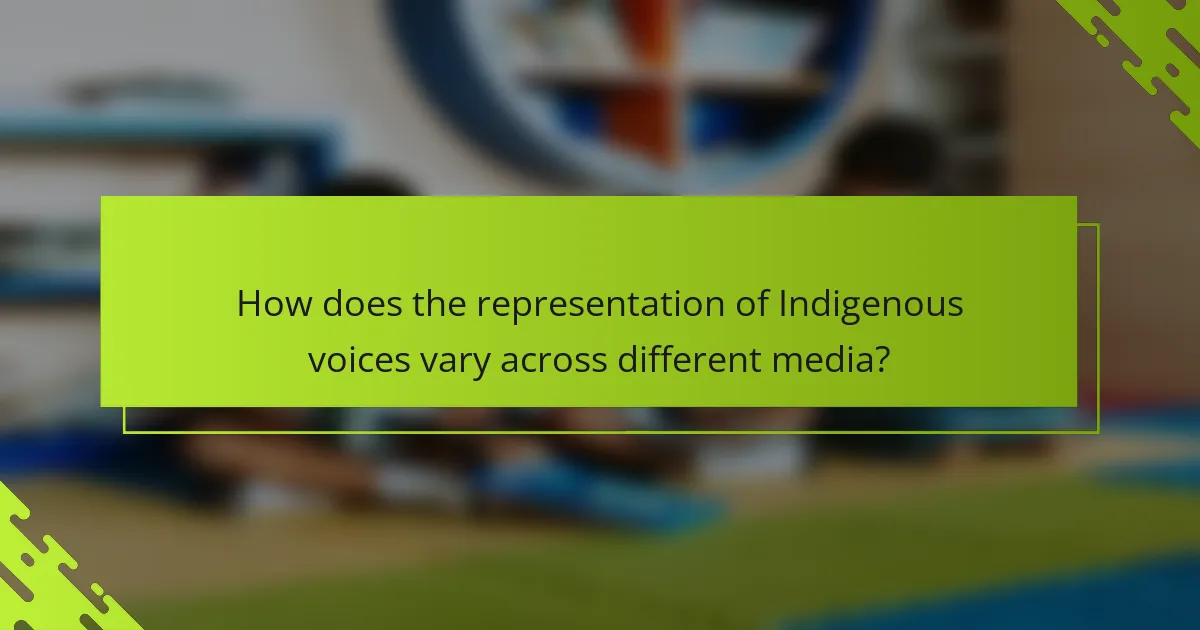
How does the representation of Indigenous voices vary across different media?
The representation of Indigenous voices varies significantly across different media due to distinct challenges and opportunities. In literature, Indigenous authors often highlight cultural narratives and social issues, contributing to a broader understanding of their experiences. In film and television, representation can be more visual but may face stereotypes. Social media provides a platform for authentic voices but can lead to misrepresentation. Each medium shapes how Indigenous stories are told and perceived, affecting audience engagement and cultural impact.
What impact do film and theatre adaptations have on Indigenous narratives?
Film and theatre adaptations significantly influence Indigenous narratives by amplifying their visibility and cultural significance. These adaptations often bring Indigenous stories to broader audiences, fostering understanding and appreciation of their complexities.
Adaptations can also challenge stereotypes, presenting nuanced portrayals of Indigenous characters and cultures. For instance, adaptations that stay true to the source material respect the unique attributes of Indigenous storytelling, such as oral traditions and community values.
However, adaptations may also present challenges, including potential misrepresentation or oversimplification of Indigenous experiences. When filmmakers prioritise commercial success over authenticity, they risk diluting the original narratives.
Overall, the impact of film and theatre adaptations on Indigenous narratives is multifaceted, shaping public perception while also posing risks to cultural integrity.
How do graphic novels and poetry amplify Indigenous stories?
Graphic novels and poetry amplify Indigenous stories by providing unique narrative forms that engage diverse audiences. These mediums allow Indigenous authors to express cultural experiences, traditions, and contemporary issues in innovative ways.
Graphic novels combine visual art with storytelling, enhancing emotional impact and accessibility. They can portray complex themes such as identity, resilience, and history through striking imagery and dialogue. For instance, authors like David A. Robertson use this format to depict Indigenous life and history, making it relatable to readers of all backgrounds.
Poetry, on the other hand, captures the essence of Indigenous voices through rhythm and metaphor. It offers a condensed form of expression that can convey deep cultural significance and personal narratives. Poets like Joy Harjo use language to evoke imagery and emotions, connecting readers to Indigenous spirituality and experiences.
Both forms challenge stereotypes and foster understanding by presenting authentic Indigenous perspectives. They serve as tools for resistance and reclamation of narratives, allowing Indigenous communities to assert their identities and share their stories with the world.

What best practices can Indigenous authors adopt for success in the literary landscape?
Indigenous authors can adopt several best practices for success in the literary landscape. Building strong networks within Indigenous communities fosters collaboration and support. Emphasising authentic storytelling allows for cultural representation and connection with readers. Engaging in literary workshops enhances writing skills and provides exposure to industry standards. Utilising social media platforms increases visibility and audience reach. Lastly, seeking mentorship from established authors can guide emerging voices in navigating challenges.
Which resources are available to support Indigenous writers?
Various resources support Indigenous writers, including grants, mentorship programmes, and literary organisations. Notable organisations like the Indigenous Literary Foundation provide funding and networking opportunities. Additionally, writing workshops focused on Indigenous narratives foster skill development. The unique cultural perspectives of Indigenous authors enrich the literary landscape, making these resources vital for their success.
What common mistakes should Indigenous authors avoid in their writing journey?
Indigenous authors should avoid cultural appropriation, stereotypes, and misrepresentation of their communities. They must prioritise authenticity and respect for their heritage in their writing journey. Additionally, overlooking the importance of language and storytelling traditions can undermine their work. Engaging with their communities for feedback is essential to ensure accuracy and relevance.
